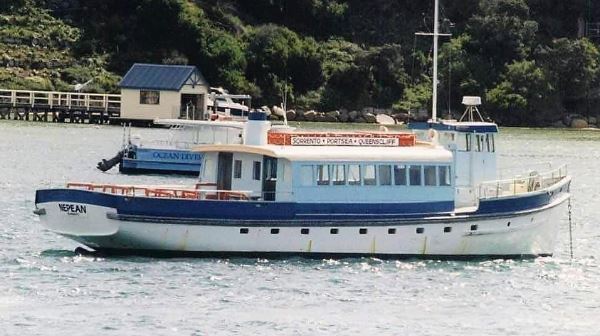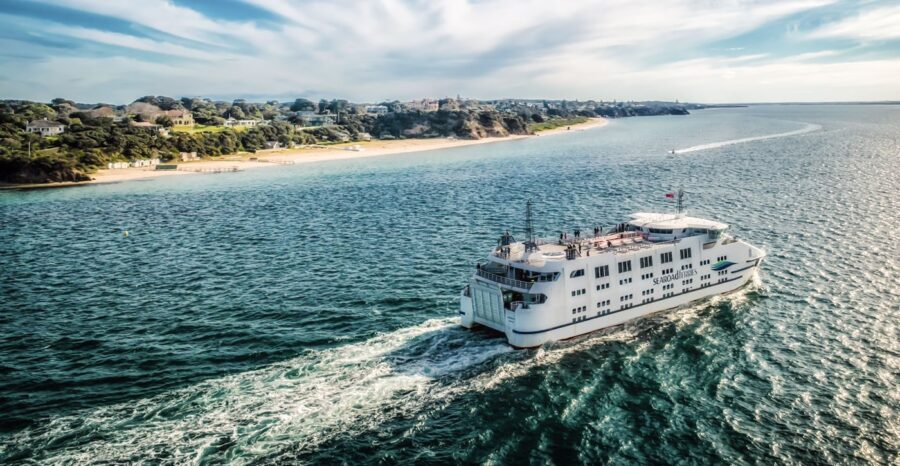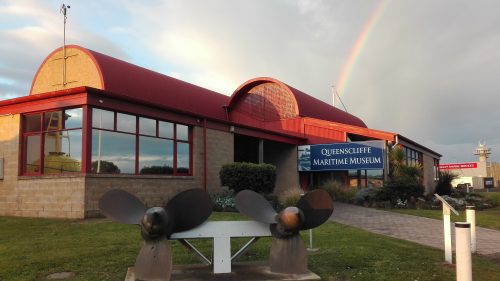
Travelling across the waters of Port Phillip Bay with friends and family has always been a spectacular adventure. There’s dolphins frolicking; ducking and diving in the waves while the landscape views are as breath-taking as ever. Since the early 1800s locals and tourists have crossed Port Phillip Bay, journeying to and from Queenscliff and Sorrento, first in luxury paddle steamers and smaller passenger ferries to the modern car and passenger ferries we have today. Whether it is for a day trip or holiday, these vessels have been providing an unforgettable way to travel this beautiful part of the Bellarine and Mornington Peninsulas.
Let’s take a closer look at the history of this iconic service, from its grand beginnings to its modern-day success.
In the early 1880’s the Williams, Golden Crown and Lonsdale paddle steamers were a common sight on the bay, running daily trips from Melbourne to Mornington, Dromana, Portsea, Sorrento and Queenscliff. These grand steamers were decked out for travelling in style with comfort, pleasure, entertainment, and fashion a top priority. The spacious promenades, elegant ladies’ salons, on board bands, dining halls and ample seating ensured everyone had a memorable experience. Their arrival at each coastal town was the highlight of the day with local hotels and guest houses sending horse drawn wagonettes and porters to the pier to bring guests back to their lodgings. Then, as the paddle steamer departed, a procession of porters, luggage, and passengers headed towards the town centre for their holiday, much like we do today.
After many decades in service the Port Phillip Bay paddle steamers were replaced by even more glamorous paddle steamers that were powerful, comfortable and fast: the Ozone, Hygeia and Weeroona. Carrying well over 1,000 passengers each they had well-stocked bars, elegant lounges, room for dancing, a barber’s shop and even electric lighting. This really was the heyday for excursions around the bay and the highlight of the year for many families. It was a time when the bay was alive with steamers, transporting holidaymakers and day trippers to the beautiful beachside villages of Port Phillip Bay.
Then, by the 1940s, these celebrated paddle steamers were taken out of service as the more compact and efficient ferries were launched. The Ozone was dismantled and sunk in the breakwater at Indented Head near Queenscliff with only the skeleton of its paddle wheel seen today as a reminder of this once great slice of history.
From the 1950s, local brothers Jack and Harry Farnsworth established a fleet of smaller passenger ferries to transport holidaymakers between Sorrento and Portsea on the Mornington Peninsula and Queenscliff on the Bellarine Peninsula. They operated mainly in the summer months and carried over 50,000 passengers a year on a varied service that depended on the season. These smaller passenger ferries continued their across-the-bay trips until the Queenscliff-Sorrento vehicle and passenger ferry service began in the 1980s. As an all-weather and year-round service, this took over as the main way to travel Port Phillip Bay.

Searoad Ferries and Port Phillip Ferries are the fast, comfortable, and convenient car and passenger ferry services we have today, sailing to Sorrento, Queenscliff, Portarlington, Geelong and Melbourne. They are changing the way commuters travel to and from work with reliable timetables and the option to sit back and relax, while still having access to your car at the other end.
The Searoad Ferries service runs between Queenscliff and Sorrento, while the newer services that Port Phillip Ferries are offering runs between Portarlington, Geelong and Docklands, Melbourne.
The ferry terminal in Sorrento is still a short walk up to the main street’s stylish hotels and boutique shops where you can enjoy a delicious lunch at the prominent Continental Hotel or one of several cafes and restaurants. Then stroll along the cliff-top Millionaire’s Walk for a pristine view of Port Phillip Bay from the backyards of some of Sorrento’s spectacular properties.
When you arrive at Queenscliff’s innovative terminal, cars and passengers are seamlessly disembarked. From there it’s a short walk to attractions like Fort Queenscliff, the Bellarine Peninsula Railway, The Blues Train and the Queenscliff Maritime Museum. There’s plenty of cafes and pubs with the historic Vue Grand, Royal Hotel and Queenscliff Hotel all offering a great feed in a heritage setting. If you bring your car across on the ferry, you open up even more opportunities to explore the cultural activities Geelong and the Bellarine Peninsula have to offer.
What cultural activities are there in and around Queenscliff?
Located just off Hesse Street in Queenscliff, the Maritime Museum offers history buffs and maritime aficionados alike, an insight into Australia’s maritime history. This museum showcases a range of displays from the early days of Australian seafaring to modern-day naval technology. Explore the interactive exhibits, educational programs and even climb aboard a replica sailing ship. There are artefacts from some of the oldest ships in Australian history, as well as interactive displays on shipbuilding and navigation. Take a guided tour or wander around at your own pace; either way, you’re sure to learn something new about maritime history.

The Queenscliffe Hub (Wirrng Wirrng) showcases the town’s rich cultural heritage through various exhibitions on local culture and art as well as educational programs that allow visitors to explore the area’s past. The name ‘Wirrng Wirrng’ is a Wadawurrung phrase that means “to listen with both ears”. Whether you’re interested in learning more about indigenous culture or just want to take part in an engaging activity, this is an ideal place to explore. You’ll also find an extensive library where you can learn more about local stories and events as well as a gift shop with locally made souvenirs.
For those looking for an immersive experience into Aboriginal culture, there’s no better place than Narana Cultural Centre in Geelong. This venue is home to one of Australia’s largest collections of Aboriginal artworks, weapons, and artefacts. Visitors can take part in guided tours which offer insight into Aboriginal culture through storytelling sessions led by local indigenous people or stroll through at your own pace, taking time to feed the friendly emus, kangaroos and wallabies. It’s guaranteed to be a memorable experience that will leave you with a greater appreciation for Australia’s Indigenous people.
The unique Salt Art Gallery is housed in the historical drapery store in Hesse St, Queenscliff. With its stunning water views, it’s certainly worth a visit. Salt Art Gallery showcases an array of modern pieces from contemporary Australian painters, sculptors, and ceramicists. Be sure to check out this stunning gallery before heading home.
Celebrate Australia’s wool industry by visiting Geelong’s National Wool Museum. The museum houses interactive exhibits that provide insight into all aspects of wool production, allowing visitors to gain a deeper understanding of how wool has shaped Australia’s economy and culture. Discover how wool has been used throughout history through activities such as spinning demonstrations and hands-on craft workshops. This museum also hosts live entertainment so make sure you check out what’s on during your visit.
The ferry service between Queenscliff and Sorrento is steeped in history and remains one of Victoria’s most popular attractions. Whether you’re looking for a fun day out with friends or an extended sightseeing adventure, the ferry service offers something for everyone. With its convenient schedule, modern amenities and stunning views of Port Phillip Bay, it’s no wonder that this iconic way to travel has been around for so long!